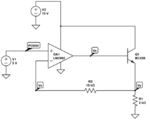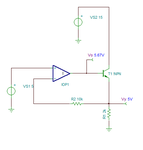Seeker_IN
Newbie level 5
I have been trying to analyse the attached circuit. the equations which I write seems not to converge when I put in Mathcad. Below are the equations which I have for the circuit
for the node Vy, (Vy-Vx)/R2+(Vy/R1)-Ic_Q1=0;
V2-Vce-Vy=0;
Vo-Vbe-Vy=0;
Vo=(POS5v-Vx+Voffset_OA1)*Avd;
Finally I need to get transfer function for Vy.
Please let me know where I am going wrong or what I am missing. Thanks
for the node Vy, (Vy-Vx)/R2+(Vy/R1)-Ic_Q1=0;
V2-Vce-Vy=0;
Vo-Vbe-Vy=0;
Vo=(POS5v-Vx+Voffset_OA1)*Avd;
Finally I need to get transfer function for Vy.
Please let me know where I am going wrong or what I am missing. Thanks

